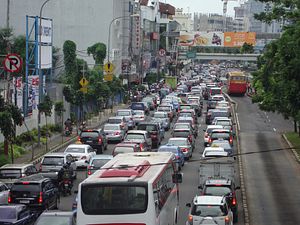The security, safety, order, and smoothness of traffic have become a big dilemma in the world’s fourth most populous country. While previously Jakarta was the only city associated with widespread traffic congestion, now other cities — such as Bandung, Yogyakarta, Semarang, and Surabaya – also suffer from traffic jams.
Traffic congestion is accompanied by an increasing number of traffic accidents. These are dominated by motorcycle accidents, which also account for the highest portion of fatalities and major injuries. Careless driving and unruly behavior by drivers are the main causes of accidents in Indonesia.
In 2014, the police reported approximately 28,000 fatalities due to accidents on the streets and roadways of Indonesia. That means about 12 deaths from traffic accidents per 100,000 people. This is very high compared to neighboring countries like Singapore (4.8) and Australia (5.2), and most researchers assume that traffic fatality numbers are still under-reported. Based on current trends, it is estimated that in 2020, traffic accidents in Indonesia will cause 40,000 deaths per year.
Besides causing deaths, deep trauma, and minor injuries, traffic accidents also create significant property damage, and this figure is also increasing. In 2010, the total nationwide financial cost reached 143 billion Indonesia rupiahs (roughly $19 million); by 2014 it had almost doubled, climbing to Rp. 250 billion.
More Vehicles, Not Enough Roads
In general, Indonesia’s traffic congestion is caused by a growth in the number of vehicles, which has outpaced the development of roads. This was predicted due to the rapid increase in the country’s population, which of course increases the demand for transportation of all kinds.
Until now, there is no strict regulation or control over the number of vehicles. As a result, it’s not uncommon for one family to have more than one vehicle, be it two-wheelers or cars. There has been a considerable rise in the number of vehicles in Indonesia, from approximately 30 million vehicles in 2004 to almost 125 million vehicles in 2016, representing an over 300 percent increase in a dozen years. The number of vehicles is estimated to be growing at around 6 million units per year, 10 to 15 percent of which are cars.
The large influx of vehicles has not been accompanied by an increase in well-built roads. The majority, if not all, of the roads in Indonesia are narrow, and do not have any dividing lines between motor vehicles and other forms of transportation. Bus, cars, motorcycles, and bicycles all use the same lane. Moreover, many roads do not have sidewalks and thus no specific pathways for pedestrians, making them very dangerous.
Lack of Law
However, congestion and the uncontrolled number of vehicles are not the only issues that must be immediately solved. The lack of traffic laws and regulations also needs scrutiny.
Impatient riders’ horns echo everywhere, and running red lights is also a common phenomenon. Cars and motorcycles are casually parked on the edge of the highway, resulting in narrower roads that produce tremendous congestion. Street vendors, despite countless instances of being evicted and disciplined by police officers, reopen their shops on those pedestrian pathways that do exist, narrowing roads even further.
No wonder road accidents in Indonesia are very frequent.
As if that weren’t enough, speed limits are often ignored. For example, even though speeds on the highway have been restricted to a maximum speed of 100 km/h, there is no tool that measures for compliance. Violations often occur and not infrequently cause accidents that injure and kill not only drivers but also other vulnerable road users such as pedestrians or motorcyclists.
Rules on the use of seat belts are also not complete, because usually only the driver is being observed. Meanwhile, passengers sitting in the back are not checked. Safety for toddlers is also ignored, as Indonesia has no law on the use of child restraints. Toddlers are usually only held by an adult, without additional safety measures.
Finally, motorists are free to drive under the influence of alcohol. Police officers in Indonesia are not equipped with alcohol detectors, because there is now law setting limits for blood alcohol concentration.
The issues above relating to Indonesian traffic require concrete action by the government. Jakarta has allocated some resources to local governments to improve traffic infrastructure. However, these funds have not been properly used and are often appropriated by corrupt stakeholders. There is a need on the part of the government to make sure that the allocated funds are used in the right way.
In addition, efforts are also needed to create strict traffic laws and regulations. Even where traffic laws are in place, they are not fully obeyed. This reality, combined with the rising number of traffic accidents, should be a catalyst for the government to enforce stricter laws and regulations.
Dikanaya Tarahita and Muhammad Zulfikar Rakhmat are independent researchers focusing on social issues in Indonesia. Both are the founders of Sekolabilitas, an Indonesian-based NGO dedicated to helping individuals with disabilities access education
































